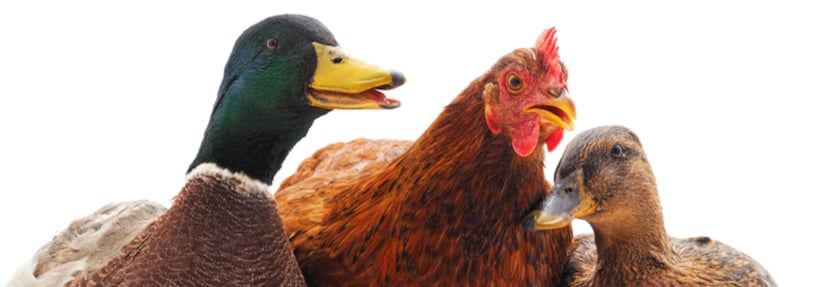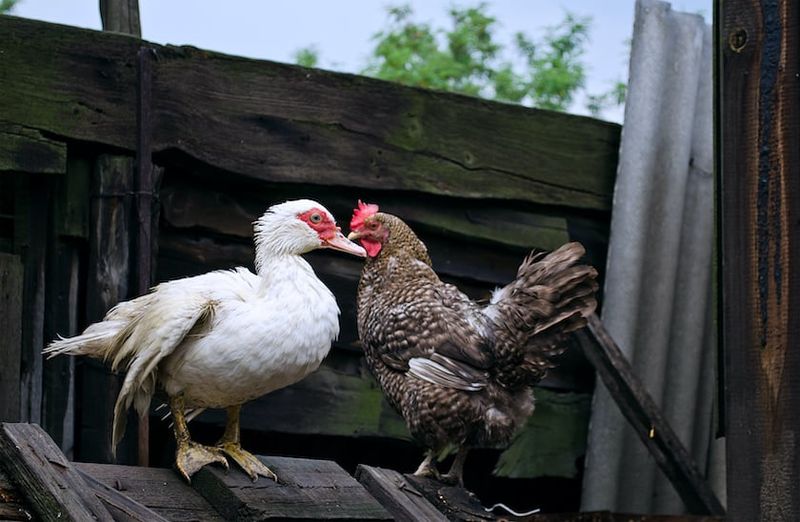Chickens and Ducks—Together?


The two species can live side-by-side with a little help
As a duck breeder, we often receive inquiries from people asking if they can have ducks or geese with their chickens. The answer is yes.
They can make great pen mates. I have been told of ducks that call after their chicken friends when the chickens fly into the neighbors yard. Or chickens coming down and cuddling with the ducks during cold weather. Many ducks have been hatched and grown by chickens. So, yes, they can co-exist quite well.
Let’s go over some questions-and-answers posed over the years.
How much space is needed?
Many backyards have chickens and ducks and geese together in harmony. The key for this is to ensure they have enough space, because each species is a bit different in their habits. If they can go through life as they see fit without interference from their neighbors, then life will be good. If they are too crowded, then there will be problems.
Our recommendations for an inside coop are 3 square feet for each chicken, 5 square feet for each duck and 15 square feet for each goose.
For an outside run, the more space the better, but we suggest at least 20 square feet per chicken, 30 square feet per duck and 60 square feet per goose. However, if you are mixing species, then add another 20-30% of space.
How about a roost for ducks?
Keep in mind that at night, chickens sleep upstairs and ducks and geese sleep on the first floor. Waterfowl live their lives on the ground—they sleep there and they make their nests there. So if you have mixed species, make sure the nests on the floor are not under the chickens’ roost where they might be filled with chicken droppings.

Can you train ducks to go up a ramp if your night coop is “upstairs?” Definitely. My nephew introduced ducks to his chickens and they dutifully learned to walk up the ramp with the chickens to a raised night pen. At that point the ducks slept on the coop floor and the chickens hopped up to their roosts.
Since ducks are on the floor you need to add some sort of bedding—typically straw or wood shavings so they stay clean and the pen stays dry. Remember, duck droppings are much wetter than chicken droppings and require more bedding to keep the pen dry.
What about water and ducks?
The typical complaint about ducks is they enjoy their water too much and make a mess of their pen.
Ducks and geese can survive in a wet pen but they do much better in a dry pen. The three main ways of preventing ducks from wetting their pen (and the first two are fine with chickens, too) is to:
1) Build a wire or plastic slat floor under their waterer so any spilled water cannot be accessed.
2) Use nipple waterers. Much less water is spilled and wasted.
3) Provide swimming water every several days…but not every day. Fill a tub or baby pool with water, let them play and clean themselves. Afterwards, dump the water far outside the pen where they cannot reach it.
How about making introductions?
When you introduce ducks to your chickens, or chickens to your ducks, just watch them initially. If there are any personality clashes, you are there and can solve them then. Just remember that the birds that have been in your flock have the home-field advantage.
Keep an eye on the “visiting team” until they know the field and locker rooms as well as the home team.
How about male-to-female ratio?
If you choose to add males, it is also important that you don’t have too many. For chickens you should have one male for every eight to fifteen hens. For ducks it is one male to three to five females.
For geese, you can have pairs in small flocks but once you get over about three males, I would start adding females so your ratio is about one male to two to four females. And if you are adding a new species, make sure you add at least two of them.
A single duck or goose in a flock of chickens will be lonely.
Do they eat the same feed?
For adult birds, you can use the same feed for chickens, ducks and geese. My only recommendation is to use crumbles or pellets, rather than mash for flocks with waterfowl as ducks and geese have more difficulty eating mash than chickens.

Ducks will want to moisten a mash they eat so they take a mouthful over to their water and try to moisten it in their mouth. So what happens? Feed is spilled and wasted.
So it is best if you stay with crumbles or pellets as that is much easier for them to swallow. Ducks and chickens appreciate the same treats so anything you are using now will be loved by your new guests, too.
How to handle Mr. Grumpy
What if you have a bad-tempered drake or rooster that is attacking or over-mating some individual birds? Again, this can happen in single species flocks, too. They either need to be separated or re-homed.
Do they brood babies the same way?
Brooding ducklings with chicks together can be an issue. Ducks typically grow much faster than chickens, and goslings grow much faster than ducklings!
The problem is not aggression but is one of clumsiness and the chance of a chick being stepped on by a lumbering duckling or gosling.
As the ducklings become much larger than the chicks, do you raise the water for the ducks so they don’t play in it or keep it low so the chicks can drink from it?

In addition, chicks are more susceptible to health issues in a wet pen than ducks—and keeping a pen dry is harder with ducks. So if you want both chickens and ducks, either raise them separately or give them plenty of space in the brooder with multiple heat lamps, feeders, and waterers with frequent additions of dry litter.
Medicated or non-medicated feed?
Years ago the medication used in chicken feed harmed waterfowl so it was recommended to not use medication in waterfowl feed. However, the drug now used predominantly by feed mills as a coccidiostat is Amprolium, which research has shown is safe for waterfowl. Therefore, medicated starter feed is safe for waterfowl.
Of course if non-medicated chick starter is available then I would use it. But I would never use a grower or maintenance feed that is not suitable for waterfowl as a starter feed just because it is not medicated.
What about niacin?
The one thing that you may need to do for ducklings eating a chicken starter feed is to supplement with niacin (vitamin B3). Ducklings require a higher level than chicks. Whereas most chicken feed has enough niacin for chickens, some rations slip below the levels required for ducks.
Instead of waiting for a problem to develop (deformed, painful legs and joints), you can easily give extra niacin for the first eight weeks when they are growing the fastest. And the additional niacin will not harm the chicks.
Our recommendation is to use either niacin tablets or vitamin packs. Assuming you purchase 500mg niacin tablets, one tablet has enough niacin for 55 ducks a day (or 55 days for one duck). Grind this up and sprinkle a bit on their feed every day.
Most poultry vitamin packs are designed to be added to 128 gallons of water. If you use a pack with at least 7500 mg of niacin, your ducks will get all the niacin they need from their water.
On bringing the two together
Whether you are a chicken fan looking to broaden your horizon or a duck enthusiast wondering about the other side, you can be comfortable in knowing that you can have chickens and waterfowl together.

It just takes a little planning and initial observation to make sure things are working. Each species has its own attributes—so have them both for the best of both worlds!
Tags:Plain Talk

Chicken Whisperer is part of the Catalyst Communications Network publication family.












